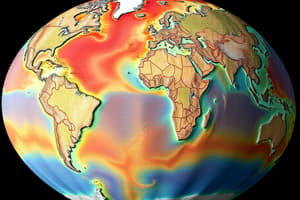Podcast
Questions and Answers
What was the name of the supercontinent that early map makers suspected the continents were once connected as?
What was the name of the supercontinent that early map makers suspected the continents were once connected as?
- Rodinia
- Laurasia
- Pangea (correct)
- Gondwana
Who proposed the theory of continental drift that was not widely accepted until the 1950s?
Who proposed the theory of continental drift that was not widely accepted until the 1950s?
- Alfred Wegner (correct)
- James Hutton
- Arthur Holmes
- Charles Lyell
What process occurs at the Mid-Atlantic Ridge where new seafloor is formed and spreads outward?
What process occurs at the Mid-Atlantic Ridge where new seafloor is formed and spreads outward?
- Convection
- Erosion
- Subduction
- Seafloor spreading (correct)
What is the name of the rigid layer of solid rock that makes up the Earth's surface and is divided into plates that move?
What is the name of the rigid layer of solid rock that makes up the Earth's surface and is divided into plates that move?
Where are volcanoes most active according to the text?
Where are volcanoes most active according to the text?
How does plate tectonics influence the rock cycle and the shaping of the Earth's crust over time?
How does plate tectonics influence the rock cycle and the shaping of the Earth's crust over time?
Flashcards are hidden until you start studying
Study Notes
- Early map makers suspected continents were once connected as a supercontinent called Pangea, which later split apart into the continents we know today.
- Alfred Wegner proposed the theory of continental drift, but it was not widely accepted until scientists in the 1950s began mapping the Mid-Atlantic Ridge and discovered seafloor spreading.
- Seafloor spreading is the process where new seafloor is formed at the Mid-Atlantic Ridge and spreads outward, indicating that the Earth's surface is in motion.
- The Earth's lithosphere, a rigid layer of solid rock, is divided into plates that move due to forces from the planet's interior, driven by convection currents in the mantle.
- Plate tectonics is the engine behind the constant transformation of the Earth's surface, causing phenomena like earthquakes and volcanic activity at plate boundaries.
- Volcanoes are most active at divergent boundaries like the Mid-Atlantic Ridge and subduction zones where oceanic plates sink beneath continental plates, creating the Ring of Fire.
- Plate tectonics not only drives geological processes like mountain formation and volcanic activity but also influences the rock cycle, shaping the Earth's crust over time in a continuous cycle of transformation.
Studying That Suits You
Use AI to generate personalized quizzes and flashcards to suit your learning preferences.




